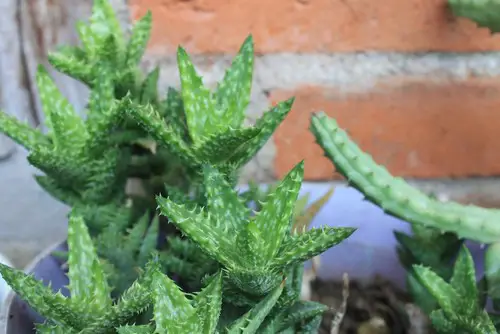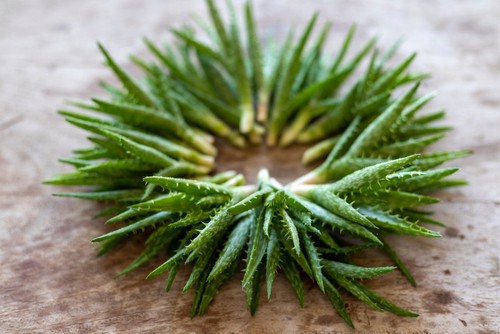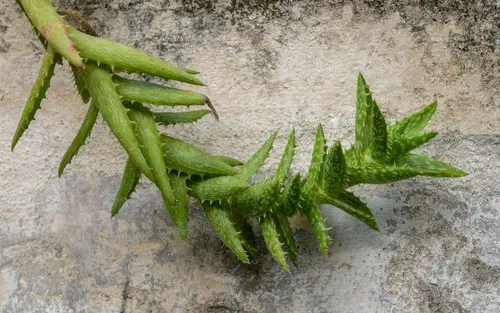Tiger Tooth Aloe is a popular succulent plant that is known for its unique appearance. However, it can be a cause for concern when the leaves start turning brown. Tiger tooth aloe turning brown can indicate a problem with the plant, and it is important to understand the causes and how to properly care for it.
Identifying the problem is the first step in addressing the issue of brown leaves on Tiger Tooth Aloe. There are several potential causes, including overwatering, underwatering, sunburn, pests, and disease. Proper care and attention can help prevent these problems and keep the plant healthy.
Proper care for Tiger Tooth Aloe involves providing the right amount of sunlight, water, and nutrients. It is also important to choose the right type of soil and pot, and to take precautions when moving the plant from indoors to outdoors.
With the right care and attention, Tiger Tooth Aloe can thrive and continue to be a beautiful addition to any home or garden.
Key Takeaways
- Understanding the causes of brown leaves on Tiger Tooth Aloe is crucial for proper care.
- Proper care involves providing the right amount of sunlight, water, and nutrients, as well as choosing the right soil and pot.
- Taking precautions when moving the plant from indoors to outdoors can help prevent problems and keep the plant healthy.
More on this category:
Understanding Tiger Tooth Aloe

Tiger Tooth Aloe, also known as Aloe Juvenna, is a succulent plant that belongs to the Aloe genus. It is a popular plant that is native to Kenya and Tanzania. The plant is named after its unique appearance, which resembles a tiger’s jaw due to the spiny edges of its leaves.
Tiger Tooth Aloe is a small, compact plant that grows up to 12 inches tall. The plant has short, straight, triangle-shaped leaves that cover the stems completely. Its “teeth” are spines that form along the leaves’ edges, making the rosette look like a tiger’s jaws.
One of the interesting features of Tiger Tooth Aloe is that its leaves turn reddish-brown when exposed to prolonged droughts or cool temperatures. This is a natural response to stress, and it is a sign that the plant is healthy and growing.
Tiger Tooth Aloe is a hardy plant that is easy to care for. It is a great addition to any succulent collection, and it can be grown both indoors and outdoors. The plant requires well-draining soil and should be watered only when the soil is completely dry.
Identifying the Problem
Tiger Tooth Aloe is a beautiful and hardy succulent that is easy to care for. However, sometimes the leaves of the plant may start turning brown, which can be a cause for concern. In this section, we will discuss the possible reasons why a tiger tooth aloe plant may turn brown and how to identify the problem.
1. Brownish-Red Leaves
If the leaves of your tiger tooth aloe are turning brownish-red, it may be a sign of sunburn. Tiger Tooth Aloe requires plenty of sunlight, but too much direct sunlight can cause the leaves to burn.
The burnt leaves will turn brownish-red and may eventually dry out and fall off. To prevent sunburn, move the plant to a location with partial shade or gradually introduce it to direct sunlight.
2. White Spots
If the leaves of your tiger tooth aloe have white spots, it may be a sign of a fungal or bacterial infection. These infections can cause the leaves to turn brown and eventually die. To prevent the spread of infection, remove the affected leaves and treat the plant with a fungicide or bactericide.
3. Dead Leaves
If the leaves of your tiger tooth aloe are turning brown and falling off, it may be a sign of overwatering. Overwatering can cause the roots to rot, which can lead to the death of the plant. To prevent overwatering, make sure the soil is well-draining and allow the soil to dry out completely between watering.
Tiger Tooth Aloe Turning Brown – 6 Common Problems

Tiger Tooth Aloe is a beautiful succulent plant that can add a touch of greenery to any indoor or outdoor space. However, sometimes the plant’s leaves can turn brown, which can be a cause for concern.
There are several reasons why tiger tooth aloe plants may turn brown. This section will explore some of the most common causes of browning and how to fix them.
1. Overwatering
One of the most common causes of browning in tiger tooth aloe plants is overwatering. When the plant is overwatered, the roots can become waterlogged, which can cause the leaves to turn brown and mushy.
To avoid overwatering, it is important to ensure that the soil is well-drained and that the plant is not sitting in standing water. It is also important to allow the soil to dry out completely between waterings.
2. Underwatering
Underwatering can also cause tiger tooth aloe plants to turn brown. When the plant is not watered enough, the leaves can become dry and brittle, which can cause them to turn brown.
To avoid underwatering, it is important to ensure that the soil is moist but not waterlogged. It is also important to water the plant regularly, especially during hot and dry weather.
3. Sunburn
Tiger Tooth Aloe plants require bright, indirect sunlight to thrive. However, too much direct sunlight can cause the leaves to turn brown and dry out. If the plant is exposed to direct sunlight for too long, it can become sunburned, which can cause the leaves to turn brown and crispy.
To avoid sunburn, it is important to ensure that the plant is placed in a location that receives bright, indirect sunlight.
4. Temperature Fluctuations
Tiger Tooth Aloe plants are sensitive to temperature fluctuations. If the plant is exposed to extreme temperatures, such as cold drafts or hot, dry air, it can cause the leaves to turn brown and dry out.
To avoid temperature fluctuations, it is important to ensure that the plant is placed in a location that is not exposed to extreme temperatures.
5. Poor Lighting
Tiger Tooth Aloe plants require bright, indirect sunlight to thrive. If the plant is not receiving enough light, it can cause the leaves to turn brown and dry out. To avoid poor lighting, it is important to ensure that the plant is placed in a location that receives bright, indirect sunlight.
6. Pests
Mealybugs are a common pest that can affect tiger tooth aloe plants. If the plant is infested with mealybugs, it can cause the leaves to turn brown and dry out. To avoid pests, it is important to inspect the plant regularly and to treat any infestations promptly.
Proper Care for Tiger Tooth Aloe

Tiger Tooth Aloe, also known as Aloe Juvenna, is a popular succulent plant that is easy to care for and adds a unique touch to any indoor or outdoor garden. However, like any other plant, it requires proper care to thrive and maintain its vibrant green color. In this section, we will discuss the essential care requirements for Tiger Tooth Aloe.
1. Watering Schedule
Tiger Tooth Aloe is a drought-tolerant plant, which means it can survive extended periods without water. However, it is crucial to avoid overwatering as it can damage the plant’s roots and cause root rot.
It is recommended to water the plant once every two weeks during the growing season and once a month during the dormant season. Ensure that the soil is dry before watering and avoid getting water on the leaves as it can cause the plant to rot.
2. Lighting Requirements
Tiger Tooth Aloe requires bright, indirect light to thrive. It is best to place the plant in a location that receives at least six hours of sunlight each day. However, avoid exposing the plant to direct sunlight as it can cause sunburn and damage the leaves.
If the plant is grown indoors, place it near a sunny window that receives bright, indirect light.
3. Temperature Control
Tiger Tooth Aloe prefers warm temperatures between 60°F to 80°F (15°C to 27°C). It is crucial to avoid exposing the plant to extreme temperatures, including below freezing temperatures, as it can damage the leaves and cause the plant to die.
It is best to keep the plant in a location with a consistent temperature and avoid placing it near air conditioning vents or drafty windows.
4. Soil and Potting Mix
Tiger Tooth Aloe requires well-draining soil to prevent water from accumulating in the pot and causing root rot. It is recommended to use a cactus potting mix or a mix of regular potting soil and perlite. Ensure that the pot has drainage holes to allow excess water to drain out.
5. Propagation and Repotting
Tiger Tooth Aloe can be propagated by removing offsets or pups that grow around the base of the plant. Allow the offset to dry for a few days before planting it in well-draining soil.
Repotting should be done once every two years or when the plant outgrows its pot. Ensure that the new pot is slightly larger than the previous one and has drainage holes.
Outdoor vs Indoor Cultivation

Growing Outdoors
Tiger Tooth Aloe can be grown outdoors in USDA Hardiness Zones 9 through 11. If you live in a climate with four seasons, you can grow Tiger Tooth Aloe as an annual during the summer months.
When grown outdoors, Tiger Tooth Aloe prefers a well-draining soil mix that is slightly acidic and rich in organic matter. It is important to ensure that the soil is not waterlogged as this can lead to root rot.
Tiger Tooth Aloe prefers direct sunlight but can also tolerate partial shade. When exposed to full sun, the plant turns brownish red in color.
Before moving the plant outdoors or increasing the amount of sunlight it receives, it is better to acclimate the plant to help prevent sunburn or sun damage. Slowly increase the amount of sunlight it receives until it is fully acclimated to the sun.
Growing Indoors
In general, Tiger Tooth Aloe is difficult to grow indoors unless it is put in front of a bright window. If you are growing Tiger Tooth Aloe indoors, it is important to ensure that it receives enough light.
An east-facing window or a south-facing window is ideal for growing Tiger Tooth Aloe indoors. If the plant is not receiving enough light, it may become leggy and the leaves may turn brown.
When growing Tiger Tooth Aloe indoors, it is important to use a well-draining soil mix that is slightly acidic and rich in organic matter. It is also important to ensure that the pot has drainage holes to prevent waterlogging.
Tiger Tooth Aloe prefers to be watered deeply but infrequently. Allow the soil to dry out completely between waterings.
If you are growing Tiger Tooth Aloe indoors, you can also consider using grow lights to supplement natural light. This can be especially helpful during the winter months when natural light is limited. A greenhouse is another option for growing Tiger Tooth Aloe indoors.
Safety Precautions
When handling Tiger Tooth Aloe, it is important to take certain safety precautions to avoid any adverse reactions. Although the plant is not toxic, its sap can cause skin irritation, so it is best to wear gloves when handling it.
It is important to note that while the plant is not toxic to humans, it can be toxic to pets. If ingested, it can cause vomiting, diarrhea, and lethargy in cats and dogs. Therefore, it is best to keep Tiger Tooth Aloe out of reach of pets and to seek veterinary attention immediately if you suspect your pet has ingested any part of the plant.
In addition to being potentially toxic to pets, Tiger Tooth Aloe can also be a choking hazard for small children. It is important to keep the plant out of reach of children and to supervise them when they are near it.
Unique Features and Uses

Tiger Tooth Aloe, also known as Aloe Juvenna, is a unique and beautiful succulent that has gained popularity due to its striking appearance and ease of care.
This clump-forming succulent has a rosette form, with bright green triangular-shaped leaves that have sharp-looking spines along their edges. Fortunately, these spines are not sharp at all, and the plant is safe to handle.
One of the unique features of Tiger Tooth Aloe is its ability to produce offsets, which are small plants that grow from the base of the parent plant. These offsets can be easily removed and planted to produce new plants.
Additionally, Tiger Tooth Aloe produces coral-orange to red blossoms that form on long stems. The blooms are an attractive addition to any garden and can last for several weeks.
Tiger Tooth Aloe is also known for its medicinal uses. The gel inside the leaves can be used to soothe burns, cuts, and insect bites. The gel can also be used to treat skin conditions such as eczema and psoriasis.
If the tips of the Aloe leaves start to turn brown and dried up, it may be a sign of overwatering or underwatering. It is important to ensure that the soil is well-draining and that the plant is not sitting in water.
Tiger Tooth Aloe can also turn reddish brown when it is happily stressed, especially when given enough exposure to the sun in the summer months.
Propagation of Tiger Tooth Aloe can be done through leaf cuttings or seeds, although it is difficult or impossible to propagate an aloe from a leaf cutting. The plant is relatively low-maintenance and can be grown both indoors and outdoors.
Tiger Tooth Aloe Around the World
Tiger Tooth Aloe, also known as Aloe Juvenna, is a succulent plant that is native to Kenya and Tanzania in East Africa. However, it is also found in other parts of the world, including Southern Africa, Socotra, and Yemen.
In Kenya and Tanzania, Tiger Tooth Aloe is commonly found growing in rocky areas and on cliffs. It is adapted to the arid and semi-arid climates of these regions, where it receives plenty of sunlight and minimal rainfall.
The plant has become a popular ornamental plant in many parts of the world due to its unique tooth-shaped leaves and striking reddish-brown color.
In Southern Africa, Tiger Tooth Aloe is found in various habitats, including grasslands, savannas, and rocky outcrops. The plant is well adapted to the dry and hot conditions of these regions and can survive extended periods of drought.
On the island of Socotra, located off the coast of Yemen, Tiger Tooth Aloe is one of the many endemic plant species found on the island. The plant is well adapted to the harsh and arid conditions of the island, where it grows on rocky slopes and cliffs.
In Yemen, Tiger Tooth Aloe is found growing in the wild in the Hadhramaut region. The plant is well adapted to the hot and dry conditions of the region and is a popular ornamental plant in many parts of the country.
Frequently Asked Questions

How do you save a tiger tooth aloe?
If your tiger tooth aloe is turning brown, it may be a sign of overwatering or poor drainage. To save your plant, you should stop watering it immediately and check the soil for moisture.
If the soil is wet, let it dry out completely before watering again. If the soil is dry, water the plant deeply and allow the excess water to drain out of the pot. You can also consider repotting the plant in a well-draining soil mix.
What to do when your aloe plant turns brown?
When your aloe plant turns brown, it is a sign of stress or damage. The first step is to identify the cause of the problem. It could be due to overwatering, underwatering, pests, diseases, or environmental factors such as too much sun or cold temperatures.
Once you have identified the cause, take appropriate measures to correct it. For example, if the plant is overwatered, stop watering it and let the soil dry out. If it is underwatered, water it deeply and regularly.
Should I remove brown aloe leaves?
Yes, you should remove brown aloe leaves as they are a sign of damage or stress. The brown leaves will not recover and may even spread the damage to other leaves.
Use a clean, sharp pair of scissors or pruning shears to remove the brown leaves at the base of the plant. Be careful not to damage the healthy leaves.
Why does aloe turn brown in the sun?
Aloe can turn brown in the sun due to sunburn or sun damage. Aloe plants are adapted to bright, indirect sunlight and can get damaged by direct, intense sunlight. The brown color is a sign of damage to the plant’s tissues and can lead to further problems if not addressed.
Can brown aloe turn green again?
Brown aloe leaves will not turn green again, but the plant can produce new, healthy leaves if the underlying problem is corrected. By identifying and addressing the cause of the brown leaves, you can help your aloe plant recover and produce new growth.
Why is my tiger aloe turning red?
Tiger tooth aloe can turn red when it is exposed to prolonged drought or cool temperatures. This is a natural response to stress and can be a sign that the plant is not getting enough water or sunlight.
If your tiger tooth aloe is turning red, make sure it is getting enough water and sunlight and consider moving it to a warmer location.

Hey, I’m Lisa and I’ve been an avid gardener for over 30 years. I love writing, talking and living in the garden! Feel free to connect with me on my socials below


